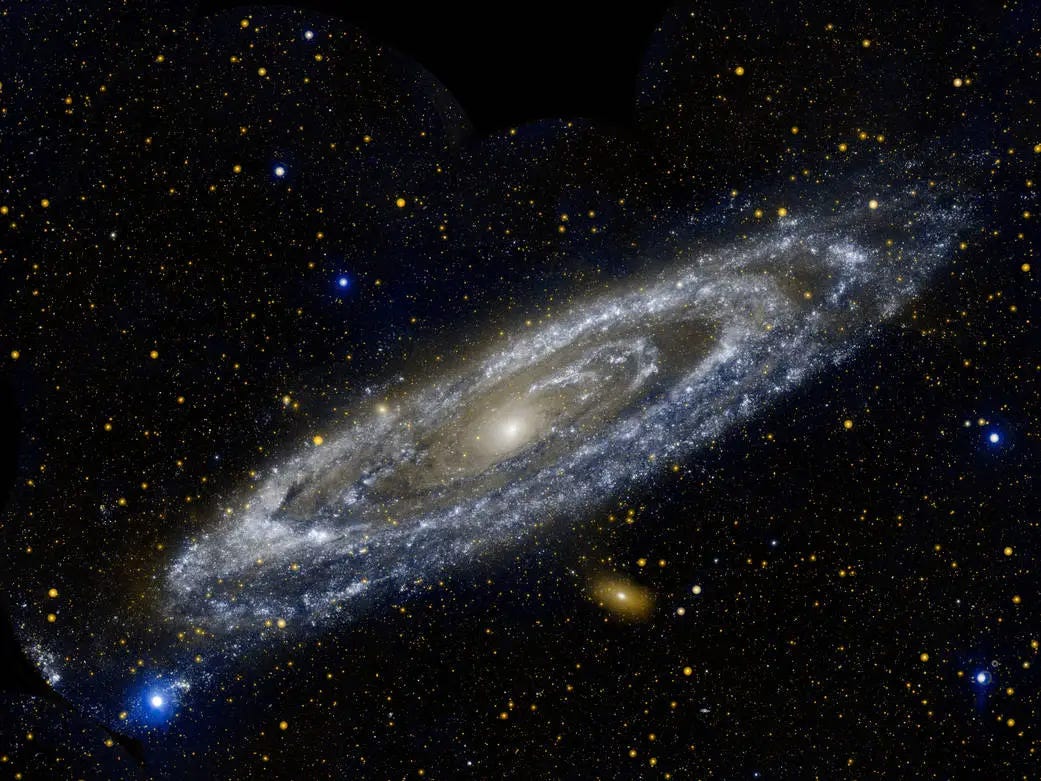Citizen Astronomer: October’s Night Sky— Meteors, Galaxies, and a Harvest Moon
This month you can chase meteors that hail from Halley’s Comet, spot neighboring galaxies with the naked eye, and watch planets return in the pre-dawn sky.
As of this writing, it’s unclear if Joshua Tree National Park will close its gates during the government shutdown that begins October 1. While the park is an official Dark Sky Park and a delightful place to watch the sky, many of these sights can be viewed from local backyards throughout the Morongo Basin. We will begin coverage of the local effects of the shutdown in the next few days.
Summer’s Milky Way begins fading earlier, but the fall constellations and crisp desert nights bring new beauties. The constellations of the fall sky begin rising from the east: Perseus, Cassiopeia, Andromeda, and Pegasus. All are part of a Greek myth involving a chained princess, a sea monster, and a winged hero. According to legend, Andromeda was offered as a sacrifice to appease the gods, but Perseus rescued her with help from Pegasus. This entire cast of celestial characters climbs higher each night, acting out the story over our heads throughout fall and winter.
The Super Harvest Moon (October 6–7)
The full moon closest to the fall equinox is known as the Harvest Moon, and it occurs in early October this year. The full moon will rise near sunset on the evening of October 6. It also qualifies as a supermoon, appearing slightly larger and brighter than usual due to its proximity to Earth. While the moonlight can make it harder to spot faint stars and galaxies, it transforms the desert landscape into a glowing, silver-lit dream. It’s a wonderful night for a moonlit walk.
Meteor Highlights: The Orionids & Draconids
October hosts two meteor showers worth staying up for.
Draconids (October 6–10)
This shower is gentler and more unpredictable but still worth a look. Because the Draconid radiant lies near Draco, they’re best seen in the evening. The peak coincides with a full moon this year, so the moonlight will outshine many of the fainter meteors, but the show is still worth watching. Enjoy the landscape bathed in moon shadow.
Orionids (October 20–22)
This is the show to catch. The Orionids originate from dust left behind by Halley’s Comet. Their meteors are fast and often bright, with peak rates under ideal conditions reaching 20 or more per hour. You don’t need to look directly at Orion—meteors will streak all across the sky. The New Moon occurs on the 21st this month, so you’ll have a full night of dark sky to take in the celestial display.
Planet Watch: Morning Returns
As the month progresses, planets begin returning to the sky before dawn. Venus climbs higher each morning in October and shines brilliantly as a morning “star.” Meanwhile, Jupiter rises earlier in the evening, growing more prominent throughout the month.
Don’t forget Saturn, still visible all night and shining in the southern sky. While its rings are currently edge-on (and difficult to discern), its soft golden glow is unmistakable and beautiful to the naked eye. Through a telescope, it remains a highlight.
Binocular & Deep Sky Gems
October offers some beautiful binocular targets:
Andromeda Galaxy (M31) On October 2, it reaches its highest point in the sky, making it easier to see. Under dark skies, it may be visible as a faint smudge with the naked eye—but binoculars bring its shape into focus.
The Pleiades As Taurus rises in the east not long after sunset, look for the Seven Sisters. This stunning open cluster is a favorite through binoculars, and one of the most distinctive and beautiful sights in the night sky.
The Double Cluster in Perseus Rising earlier each evening, this pair of open clusters is a rewarding view through binoculars or a small telescope.
Stargazing apps are great tools to zero in on these gems, as their position will change depending on the night and time you’re out for a look.
Stargazing Pro Tips for October
Go early. With the Milky Way fading and the night cooling, early evening and pre-midnight hours are great for stargazing.
Dress in layers. Desert nights get chilly, even in October—especially after midnight.
Let your eyes adjust. Give yourself 20–30 minutes in darkness and you’ll start to see more. Patience pays off under the stars.
Caitlin Gill is co-owner and Astronomy Guide for Joshua Tree Astronomy Adventures
Leave your thoughts in the comments below. Please note that we do not allow anonymous comments. Please be sure your first and last name is on your profile prior to commenting. Anonymous comments will be deleted.
Feel free to share this article!
We are $155 away from $7000 in paid subscriptions! Who’s going to take us over $7,000? Upgrade to a paid subscription for just $5 per month or $50 per year.
Would you care to donate more than $100? Our Paypal account is up and running!


